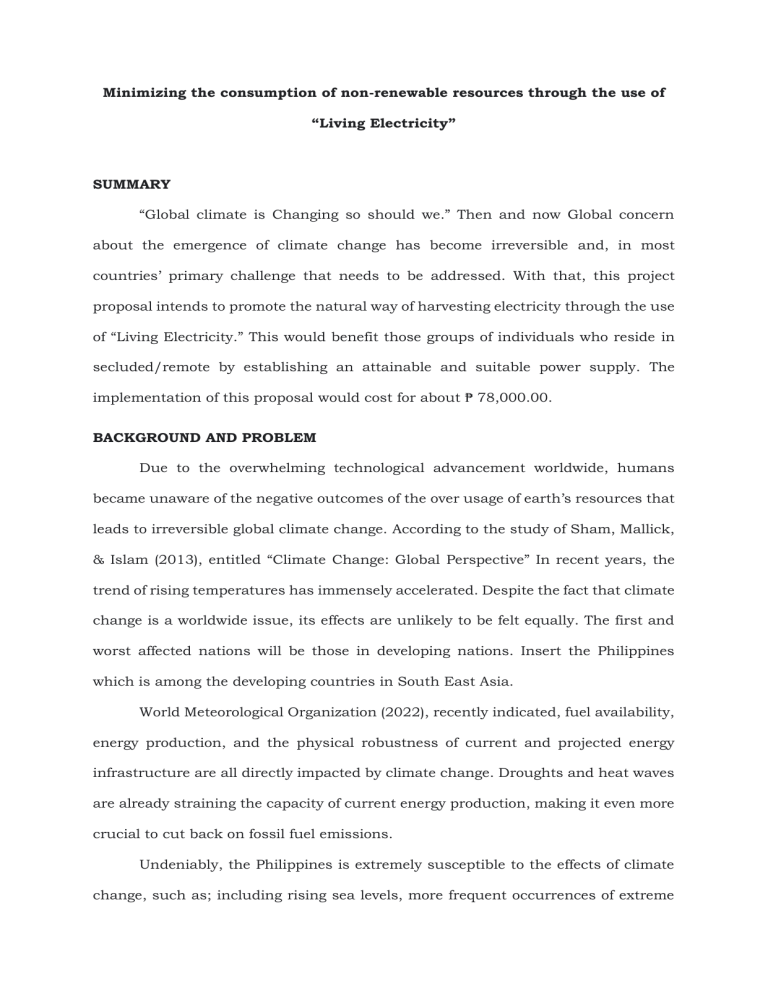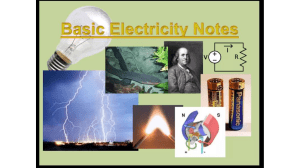
Minimizing the consumption of non-renewable resources through the use of “Living Electricity” SUMMARY “Global climate is Changing so should we.” Then and now Global concern about the emergence of climate change has become irreversible and, in most countries’ primary challenge that needs to be addressed. With that, this project proposal intends to promote the natural way of harvesting electricity through the use of “Living Electricity.” This would benefit those groups of individuals who reside in secluded/remote by establishing an attainable and suitable power supply. The implementation of this proposal would cost for about ₱ 78,000.00. BACKGROUND AND PROBLEM Due to the overwhelming technological advancement worldwide, humans became unaware of the negative outcomes of the over usage of earth’s resources that leads to irreversible global climate change. According to the study of Sham, Mallick, & Islam (2013), entitled “Climate Change: Global Perspective” In recent years, the trend of rising temperatures has immensely accelerated. Despite the fact that climate change is a worldwide issue, its effects are unlikely to be felt equally. The first and worst affected nations will be those in developing nations. Insert the Philippines which is among the developing countries in South East Asia. World Meteorological Organization (2022), recently indicated, fuel availability, energy production, and the physical robustness of current and projected energy infrastructure are all directly impacted by climate change. Droughts and heat waves are already straining the capacity of current energy production, making it even more crucial to cut back on fossil fuel emissions. Undeniably, the Philippines is extremely susceptible to the effects of climate change, such as; including rising sea levels, more frequent occurrences of extreme weather, rising temperatures, and threats to the food supply, potable water, and biodiversity, which are greatly felt. In this regard, the contestants selected this proposal to endorse to the panel of judges to test its feasibility, and how this would contribute to a sustainable development in terms of addressing the issue we face currently on the supply of electricity. BENEFICIARIES The contestants believe that this proposal is of great significance to the various institutions and groups of individuals who face an issue in terms of electricity production. Moreover, the contestants seek to know how this proposal will be beneficial to the following: For household owners who reside in secluded/remote areas, this proposal would be beneficial to this entity as they are the ones who are experiencing electric power outages due to low maintenance. Local Government Units (LGUs), this proposal is of great significance to this sector as it can give them ideas about the timely and relevant issues that are crucial to be addressed. PROPOSED SOLUTION TO THE PROBLEM I. Description Due to the distinctive makeup that most plant leaves naturally have, certain leaf structures are able to transform mechanical forces exerted at the outermost layer of the leaf into electrical power. In more detail, a process known as contact electrification enables the leaf to accumulate electric currents on its surface. The interior plant tissue is then quickly exposed to these charges. The plant tissue functions as a sort of "cable" that carries the power produced to various areas of the plant. It is, therefore, possible to harvest the electricity produced by plants and utilize it to power electrical gadgets by simply attaching a "plug" to the plant stem. Researchers from IIT demonstrate that a single leaf can create over 140 volts of voltage, which is sufficient to power 100 light bulbs concurrently. II. Objectives This proposal aims to encourage our community to use the “Living Electricity” as an alternative for using non-renewable energies that contributes to the emission of carbon footprints which causes climate change. With that, the following objectives are set: To promote natural energy resources. To decrease the emission of carbon dioxide that adds to the global warming. To provide an attainable and sustainable electric consumption. To conserve non-renewable resources. III. Strategies A. Make an informative presentation about the benefits of conducting the proposal B. Further conducting and researching about the feasibility of the target output C. Identify the agencies that can support on implementing the target output D. Conduct a visitation for those who are in most needs of the target output IV. Timeframe and Persons involved Table 1. A timetable of activities and specification of the proposed project ACTIVITIES TIMEFRAME PERSONS INVOLVED Contestants, Endorser, Submission/Endorsement of the proposed project June 5, 2023 Purchasing the necessary materials June 7, 2023 and Panel of judges Contestants and Endorsers Crafting the output: “Living Electricity” June 10, 2023 Implementation of the output to the Contestants Contestants, Endorser, July 5, 2023 localities/municipalities and LGU V. Target output “LIVING ELECTRICITY” Figure 1. Simulation of the target output: “Living Electricity” Illustrated by Bello S., (2019). The proposed target output of this proposal is called “Living Electricity.” As we all know, we cannot force everybody to save reserve energy resources. However, we can at least mitigate if not eradicate the consumption of non-renewable resources through this. Researchers named, Barbara and Mazollia in Pisa, Italy. Have discovered that living plants are literally 'green' power sources. Generating, more than 150 Volts, enough to simultaneously power 100 LED light bulbs, by a single leaf. METHODS AND DETAILS Cost analysis Table 2. Projected amount of money that is required in implementing the output REQUISITE UNIT PRICE QUANTITY NET PRICE 1. Firefly 5W MR-16 LED Daylight ₱ 130.00 200 ₱ 26,000.00 ₱ 180.00/head 15 ₱ 2,700.00 - - ₱ 50,000.00 2. Manpower 3. Expert Consolation TOTAL ₱ 78,000.00 REFERENCES: Belo S., (2019), “Researchers Successfully Generate Electricity from Plants” Retrieved from https://edgy.app/generating-electricity-from-plants Meder F., & Mazzolai B. (2018), “How plants can generate electricity to power LED light bulbs.” Retrieved from https://www.sciencedaily.com/releases/2018/12/181212093308 Sham R., Mallick F., & Islam A. (2013), “Climate Change: Global perspective.” Retrieved from https://link.springer.com/chapter/10.1007/978-4-431542490_1#:~:text=The%20trend%20of%20temperature%20change,the%20se ctors%20and%20across%20nations. World Meteorological Organization (2022), “Climate change is putting energy security at risk globally.” Retrieved from https://public.wmo.int/en/media/pressrelease/climate-change-puts-energy-security-risk.





